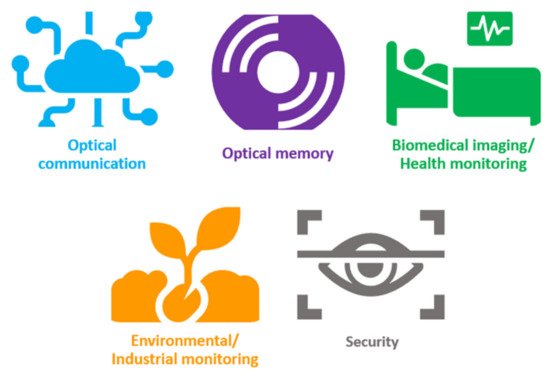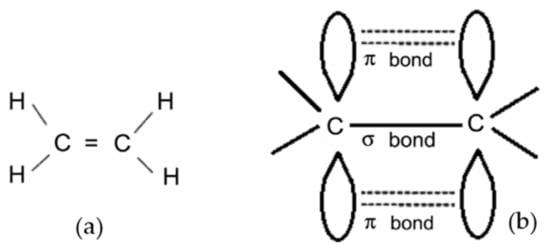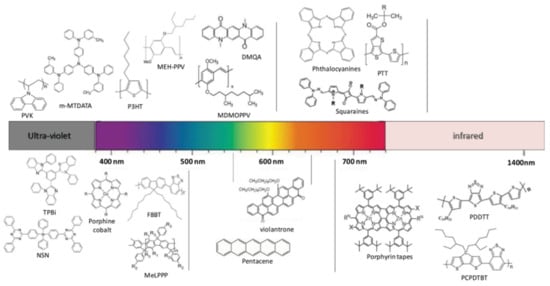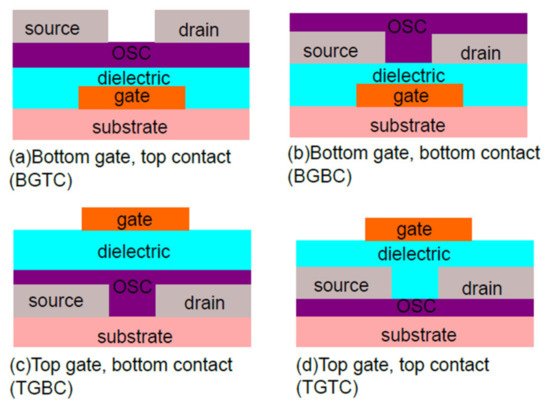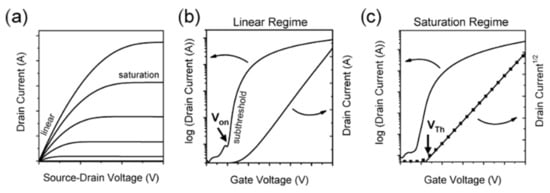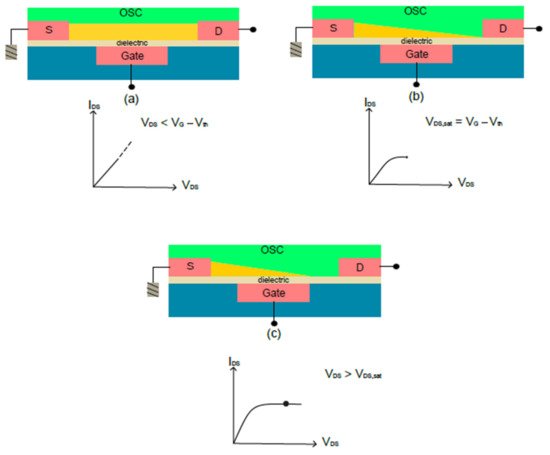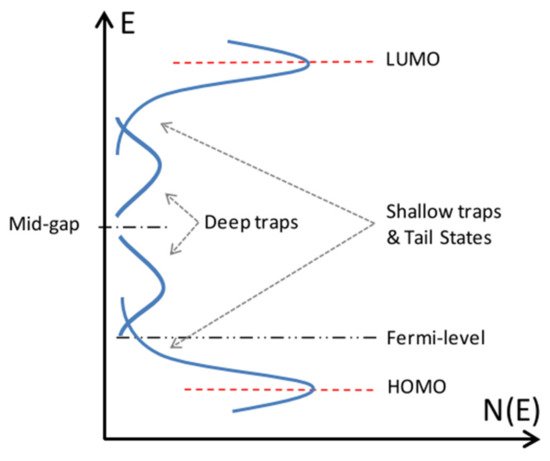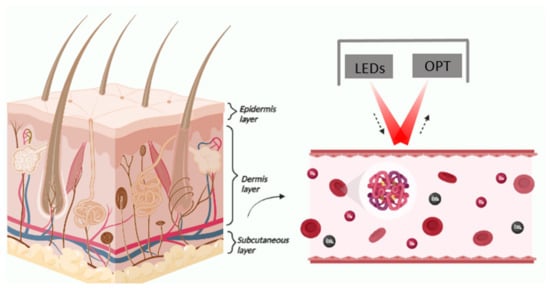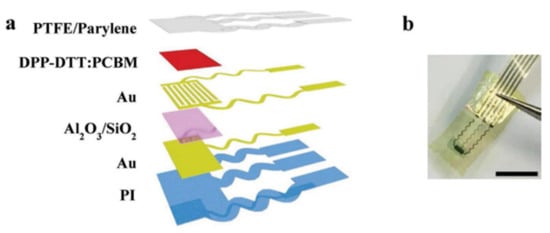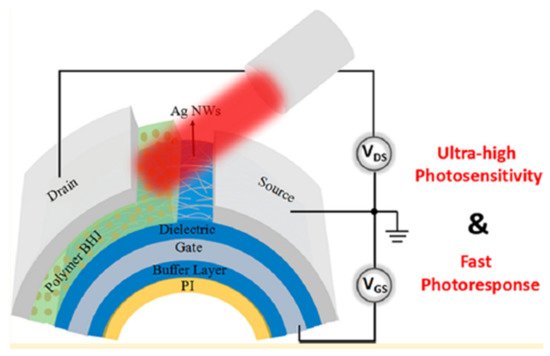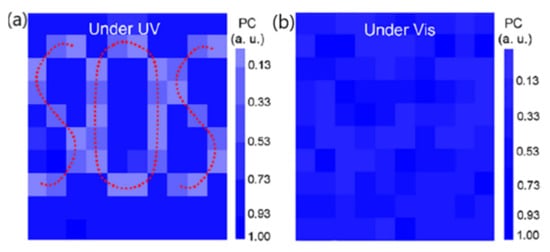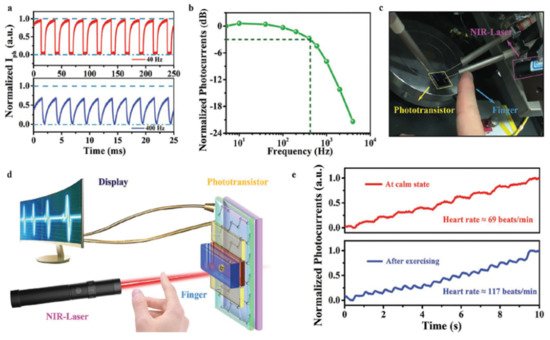The solution processing method is a promising deposition technique for fast, cost-effective, high-throughput production of electronic devices on flexible/conformal substrates. It is highly compatible with most organic semiconductors and polymeric dielectric materials. Ease of fabrication and real-time control of parameters due to low (room) temperature process makes such deposition techniques attractive for OFETs and OPT devices. Examples of widely adopted solution-processing techniques are spin coating, drop casting, dip coating, spray coating, blade coating (or roll-to-roll method) and gravure and inkjet printing. Nowadays, inkjet printing has been widely used because it offers superior advantages to frequently preferred spin-coating. Inkjet printing is a very fast method with low material consumption, printing ability of arbitrary patterns, and high resolution
[84][85]. Inkjet printing does not require direct contact with the substrates which in return reduces the risk for defects induced by contact with mechanical parts. By adopting inkjet printing, direct deposition of controlled volume of functional materials is made possible via a material-efficient approach
[86]. Fully inkjet-printed OFET prototypes are successfully attempted
[87]. Nevertheless, inkjet printing is intrinsically slower than some other high-throughput printing methods, such as gravure. Parallelization (multi-nozzle) strategies are introduced to minimize such shortcomings
[88]. The conventional channel length of inkjet-printed pattern is normally limited to about 10 μm. By using electric fields to produce the formation of a droplet (electrohydrodynamic jet printing), materials can be patterned down to a resolution of 1 μm
[89]. Smaller channel lengths can be achieved through techniques integrating printing with a self-assembly-driven process, such as self-aligned printing, in which the surface energy of a pre-printed pattern is modified with SAMs or surfactants
[90].
3. The Applications of Organic Phototransistors
Phototransistors have a wide variety of application areas, such as visible light detection, biomedical health monitoring, remote diagnostics, electronic eyes, industrial process inspection, food and water quality control, environmental surveillance, energy, optical memory, etc.
Recent advances on OPTs have been particularly focused on detection in the UV and NIR regions. UV sensors are gaining increasing attention for utilisation in the health and medical fields to prevent sunburn and skin cancer caused by sunlight
[13][14][19][33][34][35][36][37]. Detection and quantification of the intensity of UV light plays a critical role in medical diagnostics. It has already been known that UV light can have a harmful effect on skin, and overdose exposure can lead to skin cancer. One must avoid to exposure to UV light without control and/or in the absence of safety measures. On the other hand, UV light is applied for phototherapy to cure skin diseases like atopic dermatitis. Under controlled conditions and uniform pulse output, UV light can be a very useful tool in the biomedical field. For instance, UV-B sensitive, low-voltage, solution-processed, thin-film phototransistor was developed for the safe and effective treatment of skin diseases
[95]. To explore the effect of UV light on both causing and curing diseases, it is beneficial to carefully quantify the UV light. UV light is mainly divided into three groups: UV-A (400–320 nm), UV-B (315–280 nm) and UV-C (290–100 nm). Determination of the amount of UV-A and UV-B is done by some portable technologies. However, they do not offer high accuracy due to the continuous need for calibration. Dosimeters, sunscreens, UV-weakening clothes are some examples of UV exposure monitoring techniques
[14]. Nevertheless, high accuracy, real-time devices are still required for the detection of UV light. Low-voltage, solution-processed organic phototransistors are promising candidates in this field to obtain fast and accurate results. One the other hand, numerous researche have been increasingly focused on development of near IR sensors for medical diagnostics, for instance, pulse oximetry and monitoring blood pressure
[9][15]. Home-assisted (bio)medical sensors have gained more demand than ever before, due to increased hospitalisation and hospitals overcrowding during the COVID-19 pandemic
[96][97][98][99]. Photoplethysmography (PPG) sensors can be integrated into home-assisted kits and offer tremendous advantage to monitor cardiovascular and atherosclerosis disease markers, such as heart rate (HR), blood pressure (BP), heart rate variability (HRV), arterial oxygen saturation (SpO
2), arterial ageing. Most basic human characteristics can be evaluated by the flow of blood in the subcutaneous tissue. PPG sensors can detect these indicators by monitoring pulsatile changes in blood flow
[100][101][102][103]. The device can be operated in two different modes: Reflective or transmitting mode. Several studies are reported excellent work on PPG sensors
[104][105][106]. “Therapeutic window” or “diagnostic window” are taken into account when studying light absorption of the tissue. Biological tissues exhibit low absorbance. It explains why long penetration distance is critically considered in biomedical sensors, otherwise, the light is scattered by cells and proteins. The long-wavelength range (600–1600 nm) of the NIR and short-wave IR (SWIR) account for the absorption of the light throughout the tissue (
Figure 16), which can penetrate deep subcutaneous part
[5][6][15][16][37]. Red and NIR regions provide the largest contrast between the absorption of oxyhemoglobin (HbO
2) and hemoglobin (Hb), thus enabling greater accuracy and selectivity in detection. Depending on the arterial pulse, the light absorption varies, and hence the optical density and path length changes
[6][15].
Figure 16. Skin tissue and light absorption of erythrocytes. In this figure, the device mechanism is in reflective mode. This figure was created with
BioRender.com (accessed on 26 May 2021).
Xu et al. reported using solution-processed DPP-DTT: PCBM BHJ as an active layer in OPT devices as PPG sensors in the reflection mode
[15]. In this study, a hybrid design was demonstrated (
Figure 17). They utilised a 1.8 µm-thick polyimide (PI) as the substrate, due to its smooth surface, good chemical stability, biocompatibility and excellent thermal stability. The applied bilayer dielectric (Al
2O
3/SiO
2) led to achieving low operating voltage (<3 V).
Figure 17. (
a) Schematic of the device structure of the flexible OPT, (
b) figure of a freestanding OPT. Reprinted with permission from ref.
[15]. Copyright 2017 John Wiley & Sons.
To increase the mechanical stability of the sensor, PTFE/Parylene was used as the encapsulating layer. Comparing their device with commercial PPG and clinical ECG, they reported higher accuracy (0.3% error) and better performance than conventional ones, giving promises for low power and real-time monitoring sensors. For evaluating pulse pressure variation (PP mmHg) they compared their hybrid PPG (hPPG) and a commercial PPG (cPPG) with taking a reference PP. In different positions of volunteers, PP showed fluctuating results, and hPPG and reference PP exhibited similar trend. When squatting down, hPPG fitted into reference PP. Most recently, Tao et al.
[107] reported tremendous improvement in detectivity level for use in optoelectronic applications, especially UV-sensitive photodetectors. They designed a device with a BGTC configuration and chose triphenylamine-based compounds as the light-sensitive active layer. 1,6-distriphenylamineethynylpyrene (1,6-DTEP) and 2,7-distriphenylamineethynylpyrene (2,7-DTEP) were designed and synthesized, and thereafter drop cast on OTS-modified SiO
2/Si wafer. 2,7-DTEP showed P
max = 4.35 × 10
3 and R
max = 1.04 × 10
5 AW
−1. Its D* value was 5.28 × 10
16 Jones under 370 nm UV-light. Moreover, 1,6-DTEP showed P
max = 1.6 × 10
5, R
max = 2.86 × 10
6 A W
−1 and ultrahigh D* value = 1.49 × 10
18 Jones under 370 nm UV-light. They attributed their findings to production of more photogenerated carriers under high energetic illumination. They also mentioned that under 370 nm UV light, trap densities were reduced. Rhombic crystal structure of 1,6-DTEP gave the highest µ
max value (2.1 cm
2 V
−1 s
−1) in c-axis. I
on/I
off was up to 10
6. However, 2,7-DTEP gave µ value of about 0.025 cm
2 V
−1 s
−1. Overall, they concluded that tighter molecular packing of 1,6-DTEP along with longer molecular conjugation led to higher D* and µ values. Rim et al.
[10] demonstrated ultrahigh and broad spectral photodetectivity of a hybrid phototransistor for flexible electronic applications. Their phototransistor was based on a bilayer active layer that included an organic BHJ layer and an inorganic In-Ga-Zn-O (IGZO) layer. The BHJ was comprised of poly[2,6′-4,8-di(5-ethylhexylthienyl) benzo[1,2-
b;3,4-
b] dithiophene-
alt-5-dibutyloctyl-3,6-
bis(5-bromothiophen-2-yl) pyrrolo[3,4-
c] pyrrole-1,4-dione] (PBDTT-DPP) and [6,6]-phenyl C
61 butyric acid methyl ester (PC
61BM) as donor/acceptor, respectively. IGZO layer and the BHJ solutions were spin-coated in their BGTC design. The BHJ/IGZO bilayer showed strong absorption in the range of UV-NIR. LDR level of the device was found over 100 dB, which is comparable to that of conventional Si photodetectors and the maximum D* value was 3.9 × 10
12 Jones. On the other hand, P and EQE values were different for IGZO and the BHJ. For IGZO below 588 nm (EQE from 1% to 168% and for BHJ over 588 nm wavelengths showed increased EQE levels. The bendability of the OPT devices was also tested and showed no significant changes in the electrical properties for 800 cycles (bending radius = 2.5 mm). Hence, this was found suitable for flexible wearable electronic applications.
Most recently, Jiang et al.
[108] developed a transistor device that comprised of an organic solar cell and a FeNi/PDMS magnetic array covered by Ag nanowires (AgNWs). Their aim was to obtain a device that could be implemented as an artificial intelligent skin (touchless human-machine interaction) or usage in optical communication. The photoactive P3HT: PCBM layer and the magnetic array part were deposited by spin-coating. When an appropriate magnetic field was applied, the magnetic array would be placed on the bottom contact. The photocurrent flowed through the device; thus, the phototransistor was in its on-state. In other words, the magnetic part acted as a gate electrode. They also fabricated the device on PET substrate to gain flexibility. It was reported that this two-terminal, solution-processed device with high on/off current ratio (~10
8) and fast-response would shed light on future wearable applications. Li et al.
[40] studied an n-type small molecule as an active layer in BGTC OPT for the next-generation of NIR-sensitive, low-cost sensing devices. This n-type small molecule, 4,4-Difluoro-4-bora-3a,4a-diaza-
s-indacene (BODIPY-BF2), was cast from solution and showed good absorbance in the NIR region (around 850 nm). They reported that annealed (θ = 90°) film (for highly ordered texture) exhibited high mobility value (µ
sat = 1.13 × 10
−1 cm
2 V
−1 s
−1) and on/off current ratio (1.12 × 10
6). R value was reported 1.14 × 10
4 AW
−1 at 850 nm for annealed (θ = 90°) film. The dynamic photoresponse of the device was reported stable; thus, it could have served as a good light switch. The F groups of BODIPY-BF2 could provide an O
2 and/or H
2O barrier property, contributing to the device stability and lifetime. A highly flexible and novel design with ultrashort channel length was demonstrated by Zhong et al.
[109] for organic electronics applications in the Vis region. AgNWs were deposited on the dielectric layer, and a BHJ layer was chosen as the active layer (
Figure 18). Poly[2,5-bis(alkyl) pyrrolo [3,4-
c]-pyrrole-1,4(2
H,5
H)-dione-
alt-5,5′-di(thiophen-2-yl)-2,2′-(
E)-2-(2-(thiophen-2-yl) vinyl)-thiophene] (PDVT-8) and [6,6]-phenyl C
61 (PC
61BM) was used as the D/A. Solutions were prepared in a mixture of chloroform (CF) and chlorobenzene (CB). BHJ was spin-coated on the AgNWs network source electrode. For flexibility, a polyimide (PI) substrate was deposited by blade coating. Under 720 nm light illumination, high R (750 A W
−1) and P (1 × 10
6) values were recorded. D* was as high as 4.54 × 10
15 Jones.
Figure 18. Device structure of highly flexible and novel OPT. Reprinted with permission from ref.
[109]. Copyright 2018 American Chemical Society.
Solutions with different ratios of CB in the solution were prepared. The best results, e.g., lowest switch ON time of 0.72 s were achieved for 30% CB solutions. Moreover, at 30% CB concentration, the surface area of crystals was found at the highest. It was reported that 30% CB could deliver the most efficient exciton dissociation. As the bending radius went down from 54 to 18 mm, a slight decrease of R was noticed that meant the device had good mechanical stability.
Liu et al. reported
[110] that a flexible, high response OPT (BGTC configuration) could be produced by the addition of a metal-ligand charge transfer (MLCT) molecule. Ruthenium complex 1 (Ru-complex 1), a photosensitizer was used to enhance responsivity and EQE value of the device by MLCT from Ru-complex 1 to the active layer which was an n-type molecule
N,
N′-
bis(2-phenylethyl)-perylene-3,4:9,10-tetracarboxylic diimide (BPE-PTCDI). Ru-complex 1 was deposited by drop-casting. At V
G = 80 V, the highest R value (7230 A W
−1) and D* (1.9 × 10
13 Jones) were obtained. The findings were attributed to electrons injection into the active component. When illumination excited Ru-1, ground state electrons were injected into the BPE-PTCDI. Ru
2+ was oxidized to Ru
3+, which meant holes were trapped. PI substrate was selected to obtain a mechanically flexible device for wearable organic electronic, flexible image scanners, biomedical sensing gadgets applications. In their most recent study, Lee et al.
[111] used a doping agent,
tris-(pentafluorophenyl)borane (BCF), to fabricate a short-wave infrared (SWIR) OPT. They spin-coated BCF-doped polytriarylamine, poly[
N,
N′-
bis(4-butylphenyl)-
N,
N′-
bis(phenyl) benzidine) (PolyTPD) as the gate-sensing layer in the SWIR range (λ = 1000–3200 nm) and achieved R level = 538 mA W
−1 at λ = ~1500 nm and R = ~222 mA W
−1 at λ = 3000 nm. When the light was exposed to the device, the gate-sensing layer absorbed the light and generated excitons. Following that, the charge separation occurred. Therefore, more holes could be induced in the P3HT active channel. The TPA units in PolyTPD acted as an electron donor and BCF molecule as acceptor. Electron transfer from PolyTPD to BCF provided the lower bandgap required to realise the SWIR absorption. It was reported that their study was a crucial step for the nextgeneration of soft electronic applications. Bilayer heterostructure (BHS) phototransistors offer high quality device design since they have BHJ layer for light absorption and exciton separation. In addition, this design has high mobility semiconductor layer for effective charge transport. Crosslinked polymeric semiconductor and BHJ bilayers were studied in a BGTC configuration to obtain a NIR light detection for imaging applications
[112]. Crosslinked poly(
N-alkyl diketo-pyrrolo-pyrrole dithienylthieno[3,2-
b]thiophene) (PDPP-DTT) was induced on the dielectric layer as the conducting channel and BHJ (PDPP-DTT:PC
61BM) as the photoactive layer by spin-coating. PDPP-TT is a low bandgap (E
G = −1.2 eV) material. At 808 nm, the photoresponse characteristics exhibited that BHS OPTs had V
th shift to more positive voltages. When the device was exposed to NIR light, the drain current began to rise due to photogenerated carriers. The maximum R value was 2 × 10
3 A W
−1 at light intensity of 1.66 µW cm
−2. By benefiting from the electron capturing of PC
61BM, more photogenerated holes went from the BHJ layer to crosslinked conducting channel. This charge movement contributed to the drain current. F suitability in flexible electronics, bending studies was also conducted. It is reported that the maximum P was kept at 1 mm bending radius. It indicated that this novel OPT design could provide durability response to mechanical bending. In another study, a hybrid active layer was utilised to obtain a flexible NIR light-sensitive solution-processed OPT
[113]. The hybrid layer was compromised of n-type metal oxide (In
2O
3)/polymer {5,5′-
bis[3,5-
bis(thienyl)phenyl]-2,2′-bithiophene-3-ethylesterthiophene]} (PTPBT-ET) in a BGTC structure. Polymer PTPBT-ET layer was deposited by spin-coating. In
2O
3 initiated fast electron transport and PTPBT-ET was used for NIR light absorbance. The study reported a good responsivity (R = 200 A W
−1) and D* value (1.2 × 10
13 Jones). Under 810 nm-NIR light, the device had high electron density, since electrons could easily jump to the conduction band of the metal oxide. As expected, the threshold voltage showed a negative shift (from 6.9 to −1.52 ± 1.21 V). A high carrier mobility (µ) of 7.10 ± 1.31 cm
2 V
−1 s
−1 and 3.2 × 10
7 of I
on/I
off ratio was measured. The flexibility of the device was also examined by placing the device on a polyimide (PI) substrate and applying PMMA as the passivation layer. Despite slight distraction on NIR light absorbance, the passivation layer maintained to keep the electrical stability of the device under the 5 mm-radii bending test to 1000 cycles. They stated that the proposed design with hybrid materials has the potential in image sensors and wearable health monitoring.
3.1. Photoactivated Memory Devices and Their Applications
Studies of information storage in a friendly and flexible way have spiked significantly by the growing technological advancements. Today, keeping large amount of data with low power consumption and achievable high central processing unit rate are the top priorities of scientists. The molecular size of organic materials provides an increased storage capacity. Apart from classical ways of data storage, such as random-access memory (RAM), read-only memory (ROM), or hard disk drive (HDD), researchers have been focusing on memristors and field-effect transistor (FET)-based memory devices. The well- known frequently used gadget flash memory is also based on MOSFET-based memory. The emerge of flexible and wearable sensory devices, security, and communication technologies has encouraged explore of lightweight, soft and tailorable organic materials in three-terminal transistor memory devices, namely OFET, ferroelectric FET (FeFET)
[114], and electrolyte-gated transistor (EGT)
[115][116][117]. In these designs, gate electrode is the control terminal, while the transduction terminal is comprised of source and drain electrodes. When it comes to data storage, memory devices can be volatile or non-volatile
[115][116]. Volatile memory keeps the stored data only if the device is fed by a continuous voltage. After removing the voltage, the memory goes back to its initial state. However, a non-volatile memory device can continue to hold the information even if the power is switched off. FET-based non-volatile memory is attained via two different mechanisms. Basically, FeFET memory devices’ working principal benefits from polarization change by using a ferroelectric dielectric layer in the transistor
[118]. One of the most popular and used organic, solution-processable ferroelectric materials is poly(vinylidene fluoride) (PVDF) and a copolymer of VDF and trifluoroethylene (TrFE). This type of memory is based on dipole orientation. Another type of memory is based on charge/ion trapping
[119]. Trapped charges contribute to the device in the writing and erasing process. All these processes can be interpreted by the memory window which is the V
th shifting range in the writing and erasing process and has huge importance in assessing the memory device efficiency
[115][116]. P(VDF-TrFE) was used as a ferroelectric material in a TGBC, solution-processed photomemory study
[120]. An alternative unit of diketopyrrolopyrrole (DPP) and thiophene-thiazolothiazole-thiophene (TzBT)- P(DPP-TzBT) was selected as a narrow bandgap semiconductor layer. P(VDF-TrFE) contributed to two additional non-volatile states compared to traditional OPTs due to polarisation of this ferroelectric material. The device showed the low resistance state “1” after applying a −100 V gate voltage in the writing process and the high resistance state “0” following the 100 V gate voltage in the erasing process. These two states retained up to 10
3 s which was promising for the long data storage capability. Under three different states (state 0, state 1, and 60 V gate voltage state) with 10 s light pulse-80 mW/cm
2 light intensity, different photo-to-dark currents were observed. Therefore, they said that memory states could be modified by changing photo-to-dark current. When under “0” state, positive polarization occurred. That meant hole carrier density could not reach the high levels. After light illumination, free e/h pairs dissociated, giving rise to the hole carrier density. On the other hand, under “1” state, negative polarization occurred, so high hole carrier density was already induced. Higher hole carrier density was not obtained under light illumination, as it was the case in “0” state. The authors claimed that this study could shed light on information storage and flexible electronics.
Another study with both n-type and p-type materials focused on impact of dual functionality on non-volatile organic photonic transistor
[121]. In this study, rod-coil material was used as the floating gate layer due to its fine functionality. The rod part was from a conjugated core and the coil part was long alkyl side chains. This material provided the necessary charge trapping. By using this material to serve as both the charge transport and memory layer, the negative effect of the energy barrier was hindered, and this led to creating a low-power consumption (0.1 V) organic photonic memory device. Threshold voltage shifting was observed in n-type (0.84 to −7.01 V, negative shift) and p-type (positive shift) behaviour. Hence, successful charge trapping and writing process was achieved. Fast programming time (<3 s) and prolonged retention time (over 10
4 s) demonstrated a promising new approach for photonic memory applications. Xu et al.
[122]. fabricated a dual-band, hybrid (organic/inorganic) active layer phototransistor by a one-step solution, suitable for secure communication applications. The organic active layer was a 2,7-dioctyl[1]-benzothieno [3,2-b][1] benzothiophene (C8-BTBT) single-crystal array and CH
3NH
3PbI
3 NPs was the organic/ inorganic perovskite. The device presented a high R value of > 1.72 × 10
4 A W
−1 and broad absorption range (UV-Vis) in the 252–780 nm regions. The hybrid phototransistor was integrated in a matrix array (10 × 10 pixels) and performed successfully in secure communication. The C8-BTBT pattern was deposited through a shadow mask with “SOS” characters on a quartz plate, so the characters were invisible. This plate was then placed on the transistor and exposed to the light illumination. Under Vis light, no characters could be seen, since C8-BTBT had high transparency to the Vis light. On the other hand, under the UV light, the C8-BTBT absorbed the light and as the result, SOS characters appeared (
Figure 19) and remained until after UV light was removed. This approach made it possible to keep information encrypted.
Figure 19. The visibility of the “SOS” characters under (
a) UV light, (
b) Vis light. Reprinted with permission from ref.
[122]. Copyright 2019 American Chemical Society.
Moreover, Tzou, Cai and et al.
[123] fabricated a two-terminal organic phototransistor for information technologies. Their device included a resistive random-access memory (RRAM) and an organic solar cell. They reported that the field-effect stem from their chosen integration design and the vertical two-sandwich electrode design was an excellent way for high-speed optical communication and energy saving due to the short channel in the vertical design. The photocurrent from the organic solar cell was modulated by a switchable RRAM. P3HT: PCBM, the photoactive layer was spin-coated on the top of the zinc oxide (ZnO). Ag/PMMA/Au was the structure of the RRAM (
Figure 20).
Figure 20. (
a) OPT device structure, (
b) the cross-sectional FESEM image and (
c) the equivalent circuit of the device. Reprinted with permission from ref.
[123]. Copyright 2019 AIP Publishing.
The D* value of the device was calculated over 10
11 Jones in the near UV-Vis range, and the rapid switch-on and switch-off characteristics of the device was detected at 2.5 kHz. The photoresponse time was 3 µs which was the best record, and the I
on/I
off ratio 6 × 10
4. The dual control of the device suggested a remarkable advantage to be utilized in information technology, in particular for security encryption. The electric and photonic lock could be controlled separately. In other words, when the electric lock was out of the system control, their device could be controlled by the photonic lock. This meant that the information could not be stolen by hackers. Huang et al.
[124] reported a UV-sensing OPT device for photomemory storage and photodetectors by UV light programming/electrical erasing mechanism. Pentacene was selected as the active layer in the BGTC configuration. Below the active channel layer, doped aggregation-enhanced emission (AEE)–fluorescent electret film was deposited at various doping ratios. AEE-fluorescent triphenylamine (TPA)-based polymers (polyimide (PI) or polyamide (PA)) doped with an AEE small molecule (SM) electret was spin-coted. Electret layer emitted strong fluorescent illumination, following that pentacene could absorb fluorescent light. The photogenerated excitons were separated when V
G was applied. Electrons were trapped in the electret layer; thus, hole concentration in the channel increased substantially (
Figure 21).
Figure 21. Schematic diagram of programming process of OPT, (
a) OPT under the UV light, (
b) the photoinduced excitons in pentacene, (
c) charge trapping under reverse bias. Reprinted with permission from ref.
[124]. Copyright 2019 Royal Society of Chemistry.
The electrical erasing process could occur when the opposite gate voltage. Electrons were de-trapped and neutralized the holes. Their results showed memory window (MW) of 37.2 V, p value of 1.92 × 106 and R being 45 A W−1 at 365 nm.
Poor charge extraction and low dissociation can limit the OPT device working in the NIR region. Low dimensional materials including quantum dots
[125], nanowires
[126], 2D materials
[127] are reported to offer solutions for high photoconductive gain or tunable Fermi level
[128]. A novel design, solution-processed graphene/organic phototransistor was reported by He et al. for a NIR region detection
[129]. They realised a multifunctional device that could work both as a pulse monitoring and a photomemory. They induced electron extraction layer of ZnO on the graphene channel brought a strange approach to the device by blocking holes. Therefore, it could be switched into a photomemory device. A Graphene/ZnO/ Ternary bulk heterojunction (T-BHJ) was adopted in this novel, solution-processed OPT. T-BHJ (PTB7-Th:IEICO-4F:PC
71BM) was comprised of donor (D) (poly[4,8-
bis(5-(2-ethylhexyl)thiophen-2-yl) benzo[1,2-
b;4,5-
b′]dithiophene-2,6-diyl-
alt-(4-(2-ethyl-hexyl)-3-fluorothieno[3,4
b]thiophe-ne-)-2-carb-oxylate-2-6-diyl)), acceptor 1 (A1) (2,2′-((2
Z,2′
Z)-(((4,4,9,-9-tetrakis(4-hexylphenyl)-4,9-dihydro-sindaceno[1,2-
b:5,6-
b′] dithiophene2,7-diyl)
bis(4-((2ethylhexyl)oxy) thiophene-5,2-diyl)) bis(methanylylidene))
bis(5,6-difluoro-3-oxo-2,3-dihydro1
Hindene-2,1diylidene)) dimalononitrile) and acceptor 2 (A2) ([6,6]-phenyl C
71 butyric acid methyl ester) layers. T-BHJ layer expanded the response of the device to the longer wavelengths (760–1100 nm). After NIR light illumination created excitons diffused into D and A layers and became free dissociations. ZnO blocked the holes to enter the graphene layer with the help of a deep HOMO level (−7.8 eV). Hence, recombination was prevented. The OPT exhibited a high R-value (6.1 × 10
6 A W
−1) and D* (2.4 × 10
13 Jones). One of the main advantages of this study was to show pulse monitoring without contact in transmission mode (
Figure 22).
Figure 22c,d present remote pulse monitoring. Calm state and after 5-min exercise situation were compared and their results were correlated with physiological characteristics. These results were promising that human pulse and heart rate could be read out in real-time in a non-touching approach. Non-touched monitoring was in agreement with remote and non-invasive monitoring. Moreover, this OPT could be turned into a photomemory device with a retention time of 1000 s in the atmosphere as gate voltage of −20 V.
Figure 22. (
a) normalized photocurrents of the phototransistor under light modulation, (
b) normalized photocurrents as a function of modulating frequency, (
c,
d) the real image and the schematic of NIR-sensitive, pulse monitoring OPT sensor in transmission mode, respectively, (
e) author’s pulse signals and heart rate at calm state and after exercising. Reprinted with permission from ref.
[129]. Copyright 2021 John Wiley and Sons.
Furthermore, A polyimide: UV-responsive organic semiconductor 2,7-dipentyl[1]benzothieno[3,2-b][1]benzothiophene.
(PI:C5-BTBT) based, solution-processed OPT was designed
[130] and investigated under different criteria, such as blending ratio effect, UV sensitivity, and electron-withdrawing groups. C5-BTBT is a small molecule that is blind to Vis but sensitive to UV-A light. The configuration of the device was BGTC, and the active layer was spin-coated at different ratios. Their results were encouraging for photomemory applications. The 70:30 blending ratio (PI:C5-BTBT) gave the highest R (429 A W
−1) and
p was 10
6, it had lower surface roughness (2.73 ± 0.4 nm) than others as PI content increased. By introducing PI, C5-BTBT grains merged. This can be explained by the reduced grain boundaries leading to higher mobility (µ = 1.00 ± 0.17 cm
2 V
−1 s
−1). The results showed that PI:C5-BTBT blends with fast writing < 1 s, long retention times (149 s) could be preferred for the stored information applications.
3.2. Synaptic Phototransistors and Their Applications
Synaptic transistors have been widely investigated for artificial intelligence, neurological studies, and neuromorphic memory. In the human brain, when information is taken, one obeys the signal’s order to proceed. This information is then stored and processed. Synapse exists between neurons, and neurotransmitter molecules are released from pre-synaptic neurons to post-synaptic neurons. So, synaptic information begins to flow
[131]. Brain-like computer systems can resemble a biological brain, and this cycle of processes can be replicated by brain-like computers
[132][133]. Multi-terminal devices provide taking and reading signals simultaneously
[131][134]. To mimic the human brain process, it is required to input and output data which are carried out by gate electrode (input) and source-drain electrodes (output)
[135]. Synaptic transistors are devising a method where each electrode is assigned a responsibility to do. Inorganic solid electrolytes, organic solid electrolytes and inorganic-organic solid electrolytes have been applied for synaptic transistor studies as the gate dielectric layer
[131][136]. Another material, poly(vinylidenefluoride-to-trifluoroethylene) (P(VDF-TrFE)) is the one of choices. One study
[137] Qian et al. used P3HT as the active layer of the transistor, and the ionic liquid/P(VDF-TrFE) was considered as a hybrid electrolyte. This study was reported for artificial synapses for neuromorphic systems. Proton conductivity which is necessary for brain-like computers can be supplied by functional groups
[135]. In synaptic transistors, different types of electrodes can be utilized. For instance, researchers claim that metal magnesium electrodes can reduce the biocompatibility problems because there are numerous amounts of Mg
2+ ions in muscle and bone
[131][138]. Electric-double layers (EDLs) are critical when the synapse space and synaptic information flow design are aimed to be occurred. This biological transmission can be mimicked by EDLs
[131][139].
OFET can be enriched with a photonic memory feature by utilising a phototransistor design. Using light illumination in phototransistor sensor applications for biological synapse studies is extremely attractive, since 70–80% of the information that humans take from their environment is from visual sense. An OPT operates in a very similar to a biological system. Mobile charges in the channel are regarded as neurotransmitters. The channel conductance is named synaptic weight. Changes in synaptic, also known as synaptic plasticity weight, is regarded as a change in source-drain output current
[116]. A hybrid synaptic phototransistor was designed by using solution-processed perovskite CsPbBr
3/ 6,13-
bis(triisopropylsilylethynyl) TIPS in a BGTC configuration
[140]. CsPbBr
3, the light absorption layer, was spin coated, and TIPS, conducting layer was deposited by drop-casting. Using CsPbBr
3 enhanced the device photosensitivity, as pure TIPS did not high have hole sensitivity. After light illumination, the injection of photoexcited holes into the TIPS channel increased and electrons were trapped in CsPbBr
3. The learning-forgetting-relearning process was examined. The learning and relearning processes took 30 and 17 pulses respectively. This behaviour resembled that of the human brain in which relearning takes less time than first-time learning. They reported light-to-dark current ratio was 1.8 × 10
5 and R was above 2000 A W
−1. High D* (2 × 10
15 Jones) was achieved. These finding were specifically significant as conventional Si detectors have a D* value of nearly 4 × 10
12 Jones. It was stated that this study was very promising for future artificial visual systems.
Very recently, Huang et al. reported a synaptic phototransistor (SPT) for artificial intelligence vision systems
[141]. In this study, a visual system was developed to colour recognition (
Figure 23). A solution-processed, 2 D Perovskite (PEA
2SnI
4)/Organic Heterojunction (Y6) (non-fullerene acceptor material) ambipolar synaptic phototransistor was designed. PEA
2SnI
4 was selected due to its non-toxic, low temperature solution processability. Because of the difficulty of colour differentiation from Vis to NIR light, they did not study only one charge carrier (only hole or only electron). This ambipolar BGTC configuration was demonstrated to sense red/green/blue colours. The photoresponse (R) of the device was a maximum of 1.83 × 10
4 A W
−1 to visible light (blue color) and 200 A W
−1 to NIR light. R values of red and green colours were 9.25 × 10
3 and 1.21 × 10
4, respectively. The highest value of photosensitivity (
p) value recorded was 21 to visible light (blue colour) and 3 to NIR light.
p values of red and green colours were 11 and 16, respectively. NIR light was detected in positive gate voltage region that meant there was a selective detection.
Figure 23. (
a) Schematic of human visual system, (
b) process of light receiving, signal converting, and distinguishing of different colours. Reprinted with permission from ref.
[141]. Copyright 2021 John Wiley & Sons.
Moreover, this dual-mode learning device showed that it stimulated biological neurological behaviours, such as postsynaptic current, long-term memory synaptic functions. Signal transmission in the synapse occurred as light illumination, charge trapping/detrapping in artificial studies. When the light arrived at the device, excitatory postsynaptic current (EPSC) was generated, reached its peak and then decreased slightly to lower levels. The photogenerated charges were captured at the interface, and then discharged modestly in the darkness. These findings have greatly contributed to scientific understanding of and opened exciting opportunities on mimicking the human brain and its functionalities.

